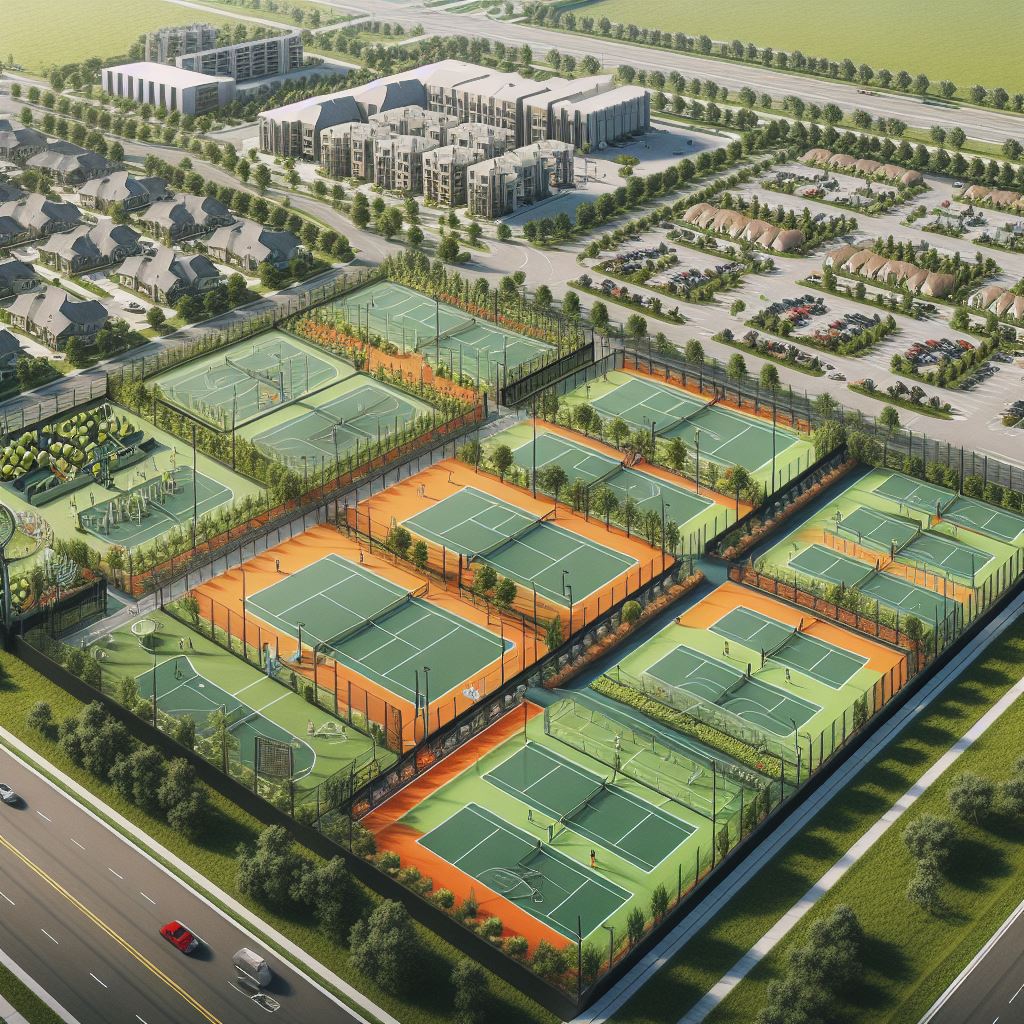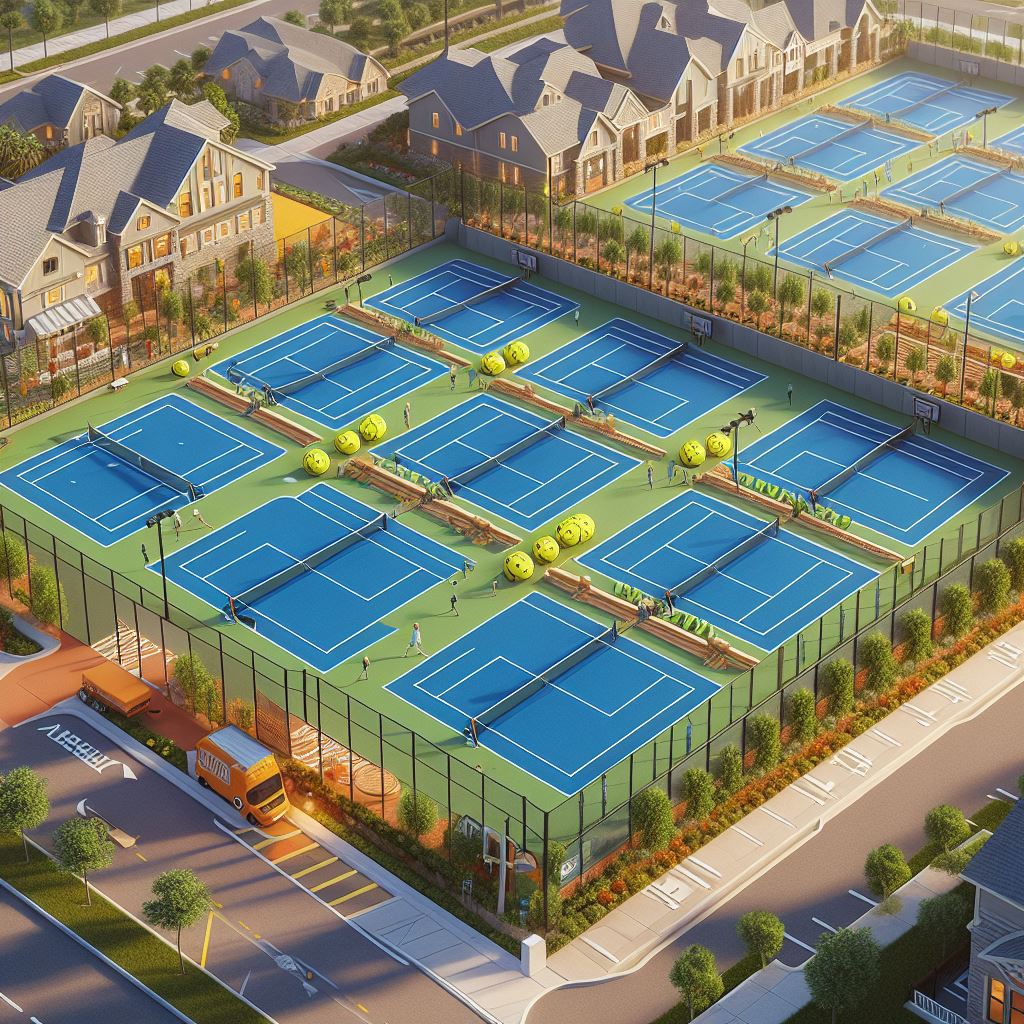In the realm of racquet sports, a surprising trend has emerged—Pickleball fever is spreading across unexpected corners of the globe, outshining its popularity even in the United States.
Forget the conventional sports narrative; this article dives into the international Pickleball craze, uncovering the surprising countries where this sensation has taken root.
Explore the vibrant world of Pickleball beyond borders and discover why its global surge is reshaping the landscape of racquet sports like never before. Embark on a journey beyond the familiar courts as we unravel the secrets of Pickleball’s unexpected triumphs.
Where Pickleball Is More Popular Than the United States?
While pickleball is often associated with the United States, where it originated, the sport is gaining popularity in surprising countries around the world. Here are a few examples:
- Canada: Pickleball is booming in Canada, with over 200,000 players and over 1,400 courts.
- Germany: Pickleball is rapidly gaining popularity in Germany, with over 10,000 players and over 300 courts.
- India: Pickleball is a relatively new sport in India, but it is already gaining traction, with over 1,000 players and over 50 courts.
- Spain: Pickleball is also popular in Spain, with over 5,000 players and over 100 courts.
These are just a few examples of the many countries where pickleball is becoming increasingly popular. The sport’s easy-to-learn rules, low impact on joints, and social aspect make it appealing to people of all ages and abilities.
- How Much Is a Pickleball Franchise?
- What to Wear To Play Pickleball? (Tips By Pickleball Experts)
- Cost Of Installing A Pickleball Court in 2024
Global Pickleball Trendsetters
Canada’s Pickleball Revolution
Canada has emerged as a powerhouse in the global pickleball scene, witnessing an unprecedented boom with over 200,000 players and a staggering 1,400 courts. The sport’s appeal goes beyond mere numbers, delving into the unique aspects that have contributed to its surge.
Community-Driven Growth
In Canada, pickleball is not just a sport; it’s a community-driven phenomenon. With players actively participating and encouraging others, the sport has become a cultural touchstone, fostering camaraderie and shared enthusiasm.
The community-driven growth is a testament to the sport’s ability to create bonds beyond the playing courts.
Influence on Infrastructure
The exponential rise in pickleball’s popularity has spurred a significant impact on infrastructure.
Public spaces and recreational centers are adapting to the demand, with an increasing number of dedicated pickleball courts.
This reflects a shift in how communities prioritize recreational activities, showcasing pickleball’s influence on shaping public spaces.

Germany’s Pickleball Surge
In the heart of Europe, Germany is witnessing a rapid surge in pickleball, boasting over 10,000 players and 300 courts.
The sport’s journey in Germany is a fascinating exploration into how a relatively new activity can captivate a diverse audience.
Cultural Adaptation
Pickleball in Germany is not just a recreation; it’s a cultural adaptation. The sport seamlessly blends with the country’s penchant for precision and strategy, making it a natural fit for those seeking an engaging and thought-provoking physical activity. The cultural adaptation is evident in the diverse age groups embracing pickleball as a preferred sport.
Pickleball’s Health Appeal
Germany’s fascination with health and well-being aligns with pickleball’s low-impact allure. The sport’s emphasis on joint-friendly movements and cardiovascular benefits resonates with individuals conscious of their fitness. This health appeal has played a pivotal role in pickleball becoming more than just a game; it’s a wellness choice.
Emerging Pickleball Culture in India
India, with over 1,000 players and 50 courts, is witnessing the emergence of a vibrant pickleball culture. The sport, although relatively new to the country, is rapidly finding its place in the diverse tapestry of Indian sports.
Youthful Adoption
The sport’s youthful adoption in India is a promising sign of its future growth. Pickleball’s simplicity and accessibility make it an attractive choice for the younger demographic. As schools and colleges embrace pickleball, it’s becoming a gateway for the youth to participate in a global sporting trend.
Cultural Integration
Pickleball’s cultural integration in India is noteworthy. Beyond being a sport, it’s becoming a cultural exchange. The game’s adaptability allows it to incorporate local nuances, making it relatable and appealing to a broader audience. This cultural integration is fostering a sense of pride and ownership among Indian pickleball enthusiasts.
Spain’s Pickleball Enthusiasts
In the vibrant landscapes of Spain, over 5,000 players and 100 courts testify to the country’s love for pickleball. Spain’s unique take on the sport provides insights into how different cultures interpret and adopt this global sensation.
Leisure and Social Integration
For many in Spain, pickleball goes beyond a competitive sport; it’s a leisure activity and a social integration tool. The sport’s adaptability to different settings, from competitive matches to friendly gatherings, aligns with Spain’s laid-back lifestyle. Pickleball has become a catalyst for social interactions, seamlessly blending competition with camaraderie.
Pickleball’s Impact on Sports Landscape
The sport’s impact on Spain’s sports landscape is noteworthy. Pickleball is not merely a trend; it’s a sports landscape influencer. As more sports enthusiasts embrace pickleball, it reshapes the traditional perception of racquet sports in Spain. The sport’s growing footprint highlights its potential to redefine the country’s sporting preferences.
Exploring Pickleball’s International Appeal
Rising Popularity Beyond U.S. Borders
The rising popularity of pickleball is no longer confined to U.S. borders. Its surge in countries like Canada, Germany, India, and Spain underscores a global fascination with this dynamic racquet sport.
Breaking Geographic Boundaries
Pickleball’s journey beyond U.S. borders signifies a breaking of geographic boundaries. The sport’s universal appeal has transcended cultural and regional differences, creating a shared platform where enthusiasts from diverse backgrounds converge to engage in a common passion. The breaking of these geographic barriers highlights pickleball’s potential as a global unifier.
The Cross-Cultural Allure
The cross-cultural allure of pickleball is palpable. As it takes root in countries with distinct cultures and traditions, the sport adapts and integrates, becoming a symbol of cross-cultural exchange. The shared experience of playing pickleball bridges cultural gaps, creating a tapestry where individuals from various walks of life connect through a mutual love for the game.

Pickleball’s Low-Impact Allure
One of the key drivers of pickleball’s international appeal lies in its low-impact allure. Unlike high-impact sports, pickleball offers a gentler alternative, making it accessible to a broader demographic.
Appeal to Different Age Groups
The sport’s appeal to different age groups is a testament to its inclusive nature. From children to seniors, pickleball accommodates various age brackets. Its low-impact characteristics make it suitable for individuals of all fitness levels, emphasizing the importance of physical activity without imposing strenuous demands on the body.
Aligning with Global Fitness Trends
Pickleball’s alignment with global fitness trends positions it as more than just a recreational activity. In an era where health and well-being take center stage, the sport offers a holistic approach to fitness. The low-impact nature of pickleball aligns with the growing awareness of maintaining a healthy lifestyle, making it an attractive choice for those prioritizing wellness.
Global Demographics and Pickleball
Understanding the global demographics of pickleball provides insights into its diverse player base and the factors contributing to its widespread adoption.
Diverse Player Profiles
Pickleball’s appeal spans across diverse player profiles. From urban professionals to suburban families and rural communities, the sport attracts individuals from various backgrounds. Analyzing the diverse player demographics sheds light on the sport’s adaptability and resonant appeal.
Cultural Integration of Pickleball
The cultural integration of pickleball further enriches its global demographics. The sport’s ability to seamlessly blend with different cultures reflects its versatility. Pickleball becomes not just a game but an integral part of local customs, fostering a sense of belonging among players worldwide.
Cultural Integration of Pickleball
The cultural integration of pickleball is a multifaceted aspect that goes beyond adapting to local customs—it actively contributes to the cultural fabric of the communities where it takes root.
Promoting Social Bonds
Pickleball’s role in promoting social bonds is evident as it becomes woven into the social fabric of communities. The sport creates opportunities for people to connect, fostering friendships and a sense of community. Pickleball’s cultural integration transcends the boundaries of a sport, becoming a catalyst for social interactions.
Influence on Local Events and Festivals
The sport’s influence on local events and festivals showcases its ability to become a cultural centerpiece. Pickleball tournaments and events contribute to the vibrancy of local celebrations, attracting participants and spectators alike. The integration of pickleball into cultural festivities reinforces its significance beyond the realm of sports.
This exploration into pickleball’s international appeal unveils a dynamic tapestry where the sport not only breaks geographical barriers but also becomes an integral part of diverse cultures, promoting inclusivity, wellness, and social cohesion.
- Can You Take a Pickleball Paddle on a Plane? Tips and Guidelines for Traveling with Your Paddle
- What Is The Best Pickleball Paddle Material? A Guide to Choosing the Right Face and Core
- When Serving in Pickleball Where Does Your Partner Stand?
The Numbers Game: Pickleball Worldwide
Player Counts Across the Globe
Exploring the player counts across the globe provides a quantitative lens into the sport’s burgeoning popularity and its impact on diverse communities.
- Canada’s Prolific Player Base: With over 200,000 players, Canada boasts a prolific player base, showcasing the sport’s deep-rooted presence in the country. The substantial number of players underscores the widespread adoption of pickleball in Canadian communities.
- Germany’s Steady Influx: Germany, with over 10,000 players, demonstrates a steady influx of enthusiasts. The growing numbers suggest a sustained interest in pickleball, with German players contributing to the sport’s expanding global network.
- India’s Promising Growth: Despite being a relatively new entrant, India’s promising growth with over 1,000 players reflects the sport’s rapid acceptance. The increasing player count signifies pickleball’s potential to become a mainstream activity in the country.
- Spain’s Enthusiastic Participation: Spain’s over 5,000 players reflect the enthusiastic participation of the Spanish community. The significant numbers emphasize the sport’s successful integration into Spain’s diverse sports landscape.
Court Infrastructure Beyond the U.S.

Beyond the U.S., the surge in pickleball’s popularity is mirrored by a corresponding increase in court infrastructure, underscoring the sport’s impact on public spaces and recreational facilities.
- Canada’s Dedicated Courts: Canada’s 1,400 dedicated courts exemplify a dedication to infrastructure. The country’s investment in providing suitable spaces for pickleball aligns with its commitment to fostering a vibrant pickleball culture.
- Germany’s Growing Facilities: Germany’s 300 courts represent a growing infrastructure, catering to the rising demand for pickleball. The increasing number of courts reflects the country’s responsiveness to the sport’s expanding footprint.
- India’s Emerging Spaces: In India, over 50 courts signify the emergence of spaces for pickleball. As the sport gains traction, the development of dedicated courts indicates a shift in India’s recreational landscape.
- Spain’s Evolving Courts: Spain’s 100 courts depict an evolving court infrastructure. The country’s commitment to providing facilities aligns with the dynamic nature of pickleball’s popularity, ensuring ample spaces for players.
Pickleball’s Social Impact Abroad
Beyond the numbers, pickleball’s social impact abroad is a key aspect that goes beyond the confines of the court, fostering connections and community bonds.
- Canada’s Community-Driven Impact: In Canada, the sport’s community-driven impact is evident. Beyond the court, pickleball becomes a catalyst for social interactions, strengthening community bonds and creating lasting friendships.
- Germany’s Wellness Community: Germany’s embrace of pickleball reflects a wellness community. The sport’s low-impact nature aligns with Germany’s emphasis on health, making it a choice that promotes not just physical activity but overall well-being.
- India’s Youthful Social Engagement: In India, pickleball’s youthful social engagement signifies more than just a sport. It becomes a platform for the younger generation to socialize, contributing to a sense of belonging and camaraderie.
- Spain’s Leisurely Gatherings: Spain’s integration of pickleball into leisurely gatherings showcases the sport’s versatility. It transforms into a social activity, bringing people together in a relaxed setting beyond the competitive aspect.
Analyzing the Growth Patterns
Analyzing the growth patterns of pickleball worldwide provides valuable insights into the trajectory of its global expansion.
- Canada’s Exponential Growth: Canada’s exponential growth in pickleball participation indicates a sustained trend. The increasing numbers suggest a sport firmly embedded in the Canadian lifestyle, with potential for continued expansion.
- Germany’s Strategic Integration: Germany’s strategic integration of pickleball into its sports landscape highlights a thoughtful approach. The steady growth reflects a deliberate effort to incorporate the sport into the country’s recreational choices.
- India’s Promising Trajectory: India’s promising trajectory showcases the sport’s potential for further expansion. As more players join the ranks, pickleball’s trajectory in India aligns with a sport on the brink of mainstream recognition.
- Spain’s Enduring Appeal: Spain’s enduring appeal for pickleball indicates more than just a passing trend. The sustained interest points to a sport firmly establishing itself in Spain’s diverse sports culture.
This exploration into the numerical landscape of pickleball unveils not only the sport’s quantitative success but also its qualitative impact on communities globally. The numbers tell a story of growth, infrastructure development, and social cohesion, underlining pickleball’s position as a dynamic force in the international sports arena.
Pickleball’s Universal Allure
Exploring pickleball’s universal allure unveils the factors that make this racquet sport not just a game but a phenomenon that transcends borders, appealing to a diverse range of individuals.
Why Pickleball Transcends Borders

Understanding why pickleball transcends borders delves into the inherent qualities that make it a global sensation, reaching beyond cultural and geographical constraints.
- Versatility of Gameplay: The versatility of gameplay is a fundamental aspect that transcends borders. Pickleball’s adaptability to different skill levels, ages, and playing environments makes it an inclusive sport that resonates universally.
- Low Barrier to Entry: The low barrier to entry contributes to the sport’s global appeal. With minimal equipment requirements and easy-to-understand rules, pickleball becomes accessible to individuals with varying levels of athletic background, fostering widespread participation.
- Cross-Cultural Adaptation: Pickleball’s cross-cultural adaptation is a testament to its universal allure. The sport seamlessly integrates into different cultural contexts, becoming a shared experience that unites players across the world.
Appealing to Diverse Age Groups
Pickleball’s universal allure is further exemplified by its appeal to diverse age groups, making it a favorite among the young and old alike.
- Youthful Engagement: The sport’s youthful engagement showcases its ability to attract younger players. With schools and colleges incorporating pickleball into their sports programs, it becomes a gateway for the youth to embrace a global sporting trend.
- Senior-Friendly Dynamics: Pickleball’s senior-friendly dynamics make it an ideal choice for older players. The low-impact nature of the sport, combined with its social aspect, provides seniors with a recreational activity that promotes both physical and social well-being.
Addressing Global Fitness Trends
Pickleball’s universal allure aligns with addressing global fitness trends, contributing to a holistic approach to well-being.
- Wellness Choice: The sport’s positioning as a wellness choice resonates with individuals prioritizing health and fitness. Pickleball’s low-impact nature addresses the growing awareness of maintaining a healthy lifestyle.
- Cardiovascular Benefits: Pickleball’s inherent cardiovascular benefits add a health-oriented dimension to its universal appeal. The sport provides a balanced mix of aerobic exercise and enjoyable gameplay, catering to fitness-conscious individuals.
The Social Fabric of Pickleball
Examining the social fabric of pickleball unveils its role in creating connections, fostering friendships, and becoming a social catalyst.
- Community Bonds: Pickleball’s impact on community bonds is profound. Whether in Canada, Germany, India, or Spain, the sport becomes a shared activity that brings people together, creating a sense of community beyond the playing courts.
- Social Integration Tool: The sport’s role as a social integration tool goes beyond competition. In Spain, for example, pickleball seamlessly blends into leisurely gatherings, emphasizing its ability to foster social interactions.
As we explore the universal allure of pickleball, it becomes evident that the sport is not just a game played with paddles and balls—it’s a global phenomenon that adapts, integrates, and unites individuals across borders, embodying the essence of inclusivity and shared passion.
Key Takeaways:
- Pickleball’s adaptability drives its universal allure.
- Dedicated court infrastructure propels global participation.
- The sport contributes to economic growth and tourism.
- Pickleball’s cultural integration fosters a sense of community.
- Its low-impact dynamics make it accessible to diverse age groups.
- Are Pickleball Clubs Profitable?
- What is Foot Fault in Pickleball?
- Can You Play Pickleball On A Volleyball Court?
Unveiling Pickleball’s Global Tapestry
In the dynamic world of racquet sports, pickleball emerges not just as a game but a global phenomenon, weaving a tapestry that transcends borders and embraces diverse communities.
From Canada’s booming enthusiasm to Germany’s strategic integration, India’s promising trajectory, and Spain’s enduring appeal, this exploration into pickleball’s international journey highlights its universal allure.
The sport’s low-impact dynamics, cross-cultural adaptation, and social integration underscore its ability to connect people worldwide.
As we unveil pickleball’s global tapestry, it becomes clear that beyond being a sport, it’s a shared experience, fostering connections and creating a vibrant international community.
Frequently Asked Questions
How has Pickleball Influenced Global Sports Trends?
Pickleball has significantly influenced global sports trends by redefining racquet sports. Its universal appeal, adaptive gameplay, and low-impact dynamics have led to a shift in preferences. As more countries integrate pickleball into their sports landscapes, it becomes a catalyst for broader changes, promoting inclusivity, wellness, and social cohesion.
What Initiatives are Taken to Boost Pickleball Participation Worldwide?
Initiatives to boost pickleball participation worldwide include infrastructural development. Countries like Canada and Germany are actively investing in creating dedicated courts, fostering community engagement, and integrating pickleball into school curriculums. These efforts aim to enhance accessibility, making the sport more available to diverse populations.
Is Pickleball Recognized on the Global Sporting Stage?
Pickleball is gradually gaining recognition on the global sporting stage. While it may not yet be an Olympic sport, its growing player counts, court infrastructure, and cross-cultural adaptation highlight its increasing prominence. The sport’s enduring appeal in countries like Spain underscores its potential for future recognition.
How is Pickleball Impacting Local Economies in Countries with Growing Popularity?
The impact of pickleball on local economies is substantial. Economic growth is witnessed through increased tourism for tournaments, the establishment of pickleball-related businesses, and the development of sports-related infrastructure. This creates job opportunities and contributes to the overall economic development of communities embracing the sport.
Can Pickleball Become a Cultural Phenomenon Globally?
Absolutely, pickleball has the potential to become a cultural phenomenon globally. Its adaptability allows it to seamlessly integrate into different cultures, becoming not just a sport but a shared experience. As more countries embrace pickleball, it has the capacity to create lasting cultural impacts, shaping the way communities engage in sports and leisure activities.
- Cost Of Installing A Pickleball Court in 2024
- How Does Pickleball Open Play Work? [Detailed Guide]
- Pickleball Court vs Tennis Court: 7 Key Differences You Need To Know
- Which Brands Are Known for Offering the Best Pickleball Shoes With Wide Toe Boxes?
- We Asked Pros: Should Your Outdoor Pickleball Shoes Fit Snug or Have Extra Room?
- 15 Best Women’s Court Shoes For Pickleball [2023]
- Pickleball for Seniors: Is it Good or Bad? (We Ask Health Professional)
